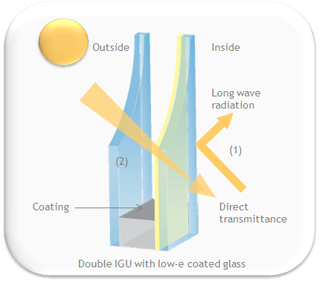Thermal Insulation Glass
Overview
Today's builders, regulators and wider communities are demanding more from glass. In particular, the focus on energy efficiency and tighter regulations are creating a greater need for low-emissivity (low-e) glass. Through advances in low-e glass, windows now play a big part in energy conservation and comfort, minimising heat loss and internal condensation.
With our wide range of low-emissivity glass we can meet all your energy saving requirements.
Effectively, low-emissivity glass will reflect energy back into a building, to achieve much lower heat loss than ordinary float glass.
How it works
Low-e glass reduces the heat loss of the building by:

(1) Reflecting the energy emitted by room heaters and surfaces back into the room (long wave radiation)
(2) Allowing high transmission of the solar radiation (short wave radiation) through the glass to benefit from passive solar heat gain through the glass.
During the winter, low-emissivity glass can reduce heat loss while allowing high levels of valuable free solar gain to heat buildings with no significant loss in natural light.
In the summer, however, it can become uncomfortably hot. To maximise energy efficiency all year round, the ideal glazing solution often combines solar control and thermal insulation.
Thermal Insulation
Heat loss is normally measured by the thermal transmittance or U-value, usually expressed in W/m2K. In its most basic terms, the lower the U-value, the greater the thermal insulation, however, the amount of free heat energy from the sun, the solar gain or g-value can also have a big impact.
Our Range
A solution for any energy-efficient requirement:
- from on-line low-e products such as Pilkington Energy Advantage™, Pilkington K Glass™ and the revolutionary vacuum glazing Pilkington Spacia™
- to extremely low Ug value off-line solutions within the Pilkington Optitherm™ range
- through to Pilkington Suncool™, Pilkington Solar-E™ and Pilkington Eclipse Advantage™ which provide both low-emissivity and solar control properties in a single product.
The ideal glazing solution often balances both solar and low emissivity performance in an insulating glass unit:
- by using a single glass which provides both solar control and low-emissivity on one pane of an insulating glass unit,
- by using both a solar control glass and a separate low-emissivity glass within an insulating glass unit.